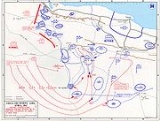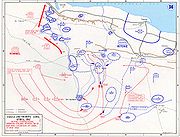
British 150th Infantry Brigade
Encyclopedia
This World War II
British Army
formation was part of the Territorial Army unit the British 50th Infantry Division. It was overrun and forced to surrender during the Battle of Gazala
in the North African campaign. For almost 72 hours (29–31 May 1942) during the battle the 150th Brigade and the 44th Royal Tank Regiment
held out against Rommel's concentrated attacks, without any support. On 1 June the Germans finally forced their surrender.
This unit was not rebuilt.
 The "Gazala Line" was a series of occupied "boxes" each of brigade strength set out across the desert with minefields and wire watched by regular patrols between the boxes. The Free French were to the south at the Bir Hakeim box. The line was not equally staffed with a greater number of troops covering the coast leaving the south less protected.
The "Gazala Line" was a series of occupied "boxes" each of brigade strength set out across the desert with minefields and wire watched by regular patrols between the boxes. The Free French were to the south at the Bir Hakeim box. The line was not equally staffed with a greater number of troops covering the coast leaving the south less protected.
By late May Rommel was ready. Facing him on the Gazala defences were 1st South African Division, nearest the coast, 50th (Northumbrian) Infantry Division (on their left) and 1st Free French Brigade
furthest left at Bir Hakeim. The British 1st and 7th Armoured Divisions waited behind the main line as a mobile counter-attacking force while 2nd South African Division formed a garrison at Tobruk and Indian 5th Infantry Division (which had arrived in April to relieve Indian 4th Infantry Division) were held in reserve.
The 150th Brigade position at the start of the battle can be seen in the map (right), it was during this battle that they were overrun and destroyed in The Cauldron by the Afrika Corps and never reformed.
27 May. German advance spotted by the 4th South African Armoured Car Regiment, at first light, at about 8:30 am on the morning of 27th they overran the 7th Armoured Division HQ. This scattered the 7th Motor Brigade. The 7th Motor Brigade, withdrew to the Retma Box, fifteen miles east of Bir Hakheim, while 4th Armoured Brigade, fought all day to stem the attackers.
By the afternoon of the 27th, the German attack had shattered the 7th Armoured Division and they were in position to assault the 201st Guards Motor Brigade, in the Knightsbridge Box.
The Germans now attacked the Box at Retma, which was garrisoned by the Rangers (9th KRRC), 2nd Rifle Brigade, 'C' Bty 4 RHA (Royal Horse Artillery
), and a Rhodesian anti-tank unit. Accompanied by heavy artillery fire the Panzers swarmed in, swiftly overrunning the 9th KRRC, with the rest of the garrison then moving back to east of Bir El Gubi. The Germans now pushed their Panzers on to the north, moving behind the Gazala Boxes, British resistance was now stiffened. To enable them to maintain their supply route round the south flank, the Germans cleared two paths through the minefield either side of the 150th Infantry Brigade Box and very heavy fighting took place in this area which was to become known as The Cauldron.
150th Brigade, with field and anti-tank artillery, held the Sidi Muftah box between the Trigh el Abd and Trigh Capuzzo, along which the enemy cut supply lines through the British minefields. The brigade kept the supply lines under artillery fire and, although it was unable to stop the flow of traffic, it made the route so ineffective that the enemy armoured divisions to the east of the minefields were reduced to a parlous state for petrol, ammunition and food. Their water ration was down to half a cup a man.
Against this isolated brigade, the enemy committed parts of German 15th Panzer Division, 101 Motorised Division Trieste and German 90th Light Infantry Division
s, supported finally by heavy bombing attacks.
Panzerarmee Afrika said in its daily battle report. "The encircled enemy, supported by numerous infantry tanks, again resisted most stubbornly", "Each separate element within the fortress-like strengthened defences had to be fought for. The enemy suffered extraordinary heavy, bloody losses. Eventually the operation, which also caused considerable losses to our troops, ended in complete success"
World War II
World War II, or the Second World War , was a global conflict lasting from 1939 to 1945, involving most of the world's nations—including all of the great powers—eventually forming two opposing military alliances: the Allies and the Axis...
British Army
British Army
The British Army is the land warfare branch of Her Majesty's Armed Forces in the United Kingdom. It came into being with the unification of the Kingdom of England and Scotland into the Kingdom of Great Britain in 1707. The new British Army incorporated Regiments that had already existed in England...
formation was part of the Territorial Army unit the British 50th Infantry Division. It was overrun and forced to surrender during the Battle of Gazala
Battle of Gazala
The Battle of Gazala was an important battle of the Second World War Western Desert Campaign, fought around the port of Tobruk in Libya from 26 May-21 June 1942...
in the North African campaign. For almost 72 hours (29–31 May 1942) during the battle the 150th Brigade and the 44th Royal Tank Regiment
44th Royal Tank Regiment
The 44th Royal Tank Regiment was an armoured regiment of the British Army during the Second World War. It was part of the Royal Tank Regiment, itself part of the Royal Armoured Corps....
held out against Rommel's concentrated attacks, without any support. On 1 June the Germans finally forced their surrender.
This unit was not rebuilt.
Structure
- 4th Battalion, Green Howards
- 5th Battalion, Green Howards
- 4th Battalion, East Yorkshire RegimentEast Yorkshire RegimentThe East Yorkshire Regiment was an infantry regiment of the line in the British Army, first raised in 1685 as Sir William Clifton's Regiment of Foot. It saw service for three centuries, before being amalgamated with the West Yorkshire Regiment , becoming The Prince of Wales's Own Regiment of...
North Africa
In April 1941 the Brigade as part of 50th (Northumbrian) Infantry Division was dispatched to the Middle East first via Cyprus, Iraq, Syria, Egypt and then into Libya as part of XIII Corps in the British Eighth Army.Battle of Gazala

By late May Rommel was ready. Facing him on the Gazala defences were 1st South African Division, nearest the coast, 50th (Northumbrian) Infantry Division (on their left) and 1st Free French Brigade
1st Free French Division
The 1st Free French Division was one of the principal units of the Free French Forces during World War II, and the first Free French unit of divisional size.-World War II:...
furthest left at Bir Hakeim. The British 1st and 7th Armoured Divisions waited behind the main line as a mobile counter-attacking force while 2nd South African Division formed a garrison at Tobruk and Indian 5th Infantry Division (which had arrived in April to relieve Indian 4th Infantry Division) were held in reserve.
The 150th Brigade position at the start of the battle can be seen in the map (right), it was during this battle that they were overrun and destroyed in The Cauldron by the Afrika Corps and never reformed.
27 May. German advance spotted by the 4th South African Armoured Car Regiment, at first light, at about 8:30 am on the morning of 27th they overran the 7th Armoured Division HQ. This scattered the 7th Motor Brigade. The 7th Motor Brigade, withdrew to the Retma Box, fifteen miles east of Bir Hakheim, while 4th Armoured Brigade, fought all day to stem the attackers.
By the afternoon of the 27th, the German attack had shattered the 7th Armoured Division and they were in position to assault the 201st Guards Motor Brigade, in the Knightsbridge Box.
The Germans now attacked the Box at Retma, which was garrisoned by the Rangers (9th KRRC), 2nd Rifle Brigade, 'C' Bty 4 RHA (Royal Horse Artillery
Royal Horse Artillery
The regiments of the Royal Horse Artillery , dating from 1793, are part of the Royal Regiment of Artillery of the British Army...
), and a Rhodesian anti-tank unit. Accompanied by heavy artillery fire the Panzers swarmed in, swiftly overrunning the 9th KRRC, with the rest of the garrison then moving back to east of Bir El Gubi. The Germans now pushed their Panzers on to the north, moving behind the Gazala Boxes, British resistance was now stiffened. To enable them to maintain their supply route round the south flank, the Germans cleared two paths through the minefield either side of the 150th Infantry Brigade Box and very heavy fighting took place in this area which was to become known as The Cauldron.
150th Brigade, with field and anti-tank artillery, held the Sidi Muftah box between the Trigh el Abd and Trigh Capuzzo, along which the enemy cut supply lines through the British minefields. The brigade kept the supply lines under artillery fire and, although it was unable to stop the flow of traffic, it made the route so ineffective that the enemy armoured divisions to the east of the minefields were reduced to a parlous state for petrol, ammunition and food. Their water ration was down to half a cup a man.
Against this isolated brigade, the enemy committed parts of German 15th Panzer Division, 101 Motorised Division Trieste and German 90th Light Infantry Division
German 90th Light Infantry Division
The 90th Light Infantry Division was a German Army division during World War II.- History :The 90th Light Infantry Division was created in August 1941 as Division z.b.V. Afrika, from units already in Africa under the control of Divisions-Kommando z.b.V. Afrika. The abbreviation z.b.V...
s, supported finally by heavy bombing attacks.
Panzerarmee Afrika said in its daily battle report. "The encircled enemy, supported by numerous infantry tanks, again resisted most stubbornly", "Each separate element within the fortress-like strengthened defences had to be fought for. The enemy suffered extraordinary heavy, bloody losses. Eventually the operation, which also caused considerable losses to our troops, ended in complete success"

